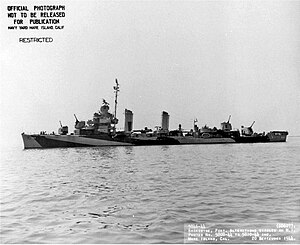USS Frazier (DD-607)
 |
|
| History | |
|---|---|
|
|
|
| Name: | USS Frazier (DD-607) |
| Namesake: | Daniel Frazier |
| Builder: | Bethlehem Shipbuilding Corporation, San Francisco, California |
| Launched: | 17 March 1942 |
| Commissioned: | 30 July 1942 |
| Decommissioned: | 15 April 1946 |
| Struck: | 1 July 1971 |
| Fate: | sold for scrap, 6 October 1972 |
| General characteristics | |
| Class and type: | Benson-class destroyer |
| Displacement: | 1,620 tons |
| Length: | 348 ft 4 in (106.17 m) |
| Beam: | 36 ft 1 in (11.00 m) |
| Draught: | 17 ft 4 in (5.28 m) |
| Installed power: | 50,000 hp (37,000 kW) |
| Propulsion: | Four Babcock & Wilcox boilers, Westinghouse geared turbines |
| Speed: | 37.5 kn (69.5 km/h) maximum, 33 kn (61 km/h) full load |
| Range: |
|
| Complement: | 191 (peace), 276 (war) |
| Armament: | 4 x 5" (127 mm)/38 caliber, 4x1.1" (28 mm) AA (1x4), 6x0.5" (12.7mm)/63¾ caliber AA, 7x20 mm AA, 5 x 21" (533 mm) torpedo tubes (1x5), 4 dcp., 2 dct. |
USS Frazier (DD-607) was a Benson-class destroyer in the United States Navy during World War II. She was named for Daniel Frazier, a US Navy sailor who served in the First Barbary War.
Frazier was launched 17 March 1942 by Bethlehem Steel Corporation, San Francisco, California; sponsored by Mrs. Richard McCullough; and commissioned 30 July 1942, Lieutenant Commander Frank Virden in command.
Frazier arrived at Noumea, New Caledonia, 9 December 1942 in the escort for a group of troop transports. She served on escort and patrol in the South Pacific for the next 4 months, guarding transports to Guadalcanal, patrolling off Espiritu Santo, and covering escort carriers as they patrolled the waters between Efate and the Solomon Islands. On 18 March 1943, Frazier departed Efate bound for Pearl Harbor and a rendezvous with a task force assigned to operate in the Aleutian Islands.
After firing in the preinvasion bombardment, Frazier covered the landings on Attu 11 May 1943, and patrolled off that island and Kiska, Alaska. On 12 May, she sighted two periscopes and opened gunfire on I-31 who dived quickly but not before Frazier had scored hits on the periscopes. Immediately gaining sonar contact, the destroyer began a depth charge attack which brought air bubbles, oil, and debris to the surface. Two more attacks ensured the submarine was sunk.
...
Wikipedia
